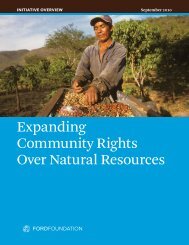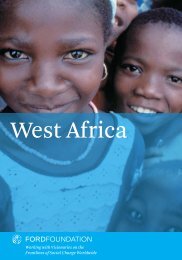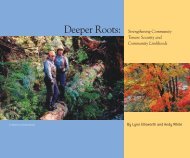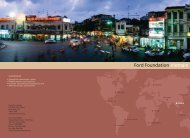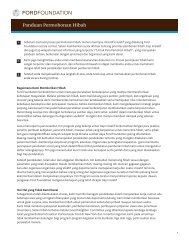Inclusive Scholarship: Developing Black Studies - Ford Foundation
Inclusive Scholarship: Developing Black Studies - Ford Foundation
Inclusive Scholarship: Developing Black Studies - Ford Foundation
You also want an ePaper? Increase the reach of your titles
YUMPU automatically turns print PDFs into web optimized ePapers that Google loves.
<strong>Inclusive</strong> <strong>Scholarship</strong>: <strong>Developing</strong> <strong>Black</strong> <strong>Studies</strong> in the United States 225<br />
and African American <strong>Studies</strong>.” This consortium grew out of the <strong>Ford</strong>funded<br />
Chesapeake Seminar of 1997–99, which attracted faculty from<br />
HBCUs in the Chesapeake region. At Cornell, the ASRC’s <strong>Ford</strong> project linking<br />
upstate New York–based consortium with Baltimore’s Morgan State<br />
University, was particularly impressive for its use of teleconferencing, distance-learning<br />
technology, and its onsite “common seminar.”<br />
The relationship between the institutionalization of African American<br />
<strong>Studies</strong> and the diversifying of faculty at schools where such units exist<br />
is a complex one—particularly with the diminished commitment to ethnic<br />
diversity at all levels at a number of major universities and colleges. The<br />
building of African American <strong>Studies</strong> units in the late 1960s and early 1970s<br />
created a mechanism, a highly strategic one, for adding blacks to college<br />
faculties that had long been segregated by race and also by gender.Although<br />
some of these African American <strong>Studies</strong> units are now celebrating their<br />
25th and 30th anniversaries, this approach to diversifying faculties has a<br />
mixed record in recruitment, retention, and promotion of <strong>Black</strong> professors.<br />
We see a high point of sorts on this front in the early and mid-1980s, when<br />
many schools earmarking funds for the hiring of African American faculty<br />
members. The effectiveness of this strategy depended upon an institutional<br />
commitment to what came to be known as “Target of Opportunity” appointments.<br />
Unfortunately, such appointments too often became the only<br />
way in which departments would hire individuals from underrepresented<br />
racial and ethnic groups (and in some cases, women). Over the past decade,<br />
the faltering interest in building an ethnically diverse faculty has been reflected<br />
by the drying up of Target of Opportunity funds or, at some institutions,<br />
by the use of such moneys to support spousal hires or the<br />
appointment of white males in particularly desirable specialization.<br />
Arelatedissueinvolvesthedecisionaunitmustmakeaboutpursuingjunior<br />
versus senior faculty appointments inAfricanAmerican <strong>Studies</strong>.On the one<br />
hand, hiring at the junior level is risky for a number of reasons, the most obvious<br />
of which is thatittakesatleastsix yearsbefore the facultymember is tenured<br />
(if he or she is promoted at all) and thus becomes a stable factor in the curriculum<br />
and research agenda of the unit. This process is both time-consuming and







